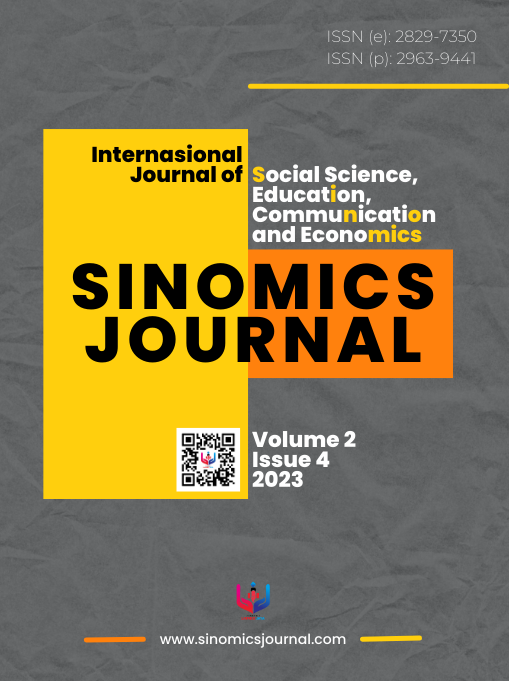The Effect of Financial Literacy, Income, And Financial Planning on Stock Investment Decisions
Main Article Content
Bellia Nanda Prastiwi
Helianti Utami
Dodik Juliardi
This study examines the effect of financial literacy, income, and financial planning on stock investment decisions. The population in this study uses young workers who are members of the Beginner Stock Investor (ISP) community. This study used a questionnaire distributed to members of the ISP community in East Java as a sample, with 100 respondents. Sampling using non-probability sampling with a purposive sampling approach. This study uses descriptive and multiple linear regression analysis to test the hypothesis. From the multiple linear regression analysis results, the researchers found that financial literacy, income, and financial planning affect stock investment decisions.
A. Robb, C., & S. Woodyard, A. (2011). Financial Knowledge And Best Practice Behavior. Journal of Financial Counseling and Planning, 22(1), 60–70. https://papers.ssrn.com/sol3/papers.cfm?abstract_id=2061308
Agarwal, S., Amromin, G., Ben-David, I., Chomsisengphet, S., & Evanoff, D. D. (2015). Financial literacy and financial planning: Evidence from India. Journal of Housing Economics, 27, 4–21. https://doi.org/10.1016/j.jhe.2015.02.003
Ahmad, M., & Shah, S. Z. A. (2020). Overconfidence heuristic-driven bias in investment decision-making and performance: mediating effects of risk perception and moderating effects of financial literacy. Journal of Economic and Administrative Sciences, 38(1), 60–90. https://doi.org/10.1108/jeas-07-2020-0116
Alaaraj, H., & Bakri, A. (2020). the Effect of Financial Literacy on Investment Decision Making in Southern Lebanon. International JBusiness and Accounting Research Journal, 4(1), 37–43. https://doi.org/http://dx.doi.org/10.15294/ibarj.v4i1.118
Aminatuzzahra. (2014). Persepsi Pengaruh Pengetahuan Keuangan, Sikap Keuangan, Sosial Demografi Terhadap PerilakuKeuangan Dalam PengambilanKeputusan Investasi Individu(Studi Kasus Pada Mahasiswa Magister Manajemen Universitas Diponegoro). Jurnal Bisnis Strategi, 23(2), 70–96.
Atkinson, A., & Messy, F.-A. (2012). Measuring financial literacy: results of the OECD infe pilot study. OECD Working Papers on Finance, Insurance and Private Pensions, 15(15), 1–73. https://doi.org/https://doi.org/10.1787/5k9csfs90fr4-en
Bairagi, P., & Chakraborty, A. (2018). Effect Of Gender, Age And Income On Investors’ Risk Perception In Investment Decision : A Survey Study. IUJ Journal of Management, 6(2), 40–45. https://doi.org/10.2139/ssrn.3843470
Boon, T. H., Yee, H. S., & Ting, H. W. (2011). Financial literacy and personal financial planning in Klang Valley, Malaysia. International Journal of Economics and Management, 5(1), 149–168.
Davar, Y. P., & Gill, S. (2007). Investment Decision Making: An Empirical Study of Perceptual View of Investors. Metamorphosis, 6(2).
Garg, N., & Singh, S. (2018). Financial literacy among youth. International Journal of Social Economics, 45(1), 173–186. https://doi.org/10.1108/IJSE-11-2016-0303
Gedminienė, D., & Visockaitė, A. (2016). The importance of personal finance for investment and applying financial behaviour principles in personal finance investment decisions in Lithuania. Socialinių Mokslų Studijos, 8(1), 118–131. https://doi.org/10.13165/SMS-16-8-1-7
Hamza, N., & Arif, I. (2019). Impact of Financial Literacy on Investment Decisions: The Mediating Effect of Big-Five Personality Traits Model. Market Forces Research Journal, 14(1), 43–60. https://kiet.edu.pk/marketforces/index.php/marketforces/article/view/386
Hassan Al-Tamimi, H. A., & Anood Bin Kalli, A. (2009). Financial literacy and investment decisions of UAE investors. Journal of Risk Finance, 10(5), 500–516. https://doi.org/10.1108/15265940911001402
Isidore R, R., & Christie, P. (2019). The relationship between the income and behavioural biases. Journal of Economics, Finance and Administrative Science, 24(47), 127–144. https://doi.org/10.1108/JEFAS-10-2018-0111
Jayaraman, J. D., & Jambunathan, S. (2018). Financial literacy among high school students: Evidence from India. Citizenship, Social and Economics Education, 17(3), 168–187. https://doi.org/10.1177/2047173418809712
Lutfi. (2010). The Relationship between Demographic Factors and Investment Decision in Surabaya. Journal of Economics, Business and Accounting Ventura, 13(3), 213–224. https://doi.org/10.3844/ijrnsp.2010.25.28
Mouna, A., & Anis, J. (2017). Financial literacy in Tunisia: Its Determinants and Its Implications on Investment Behavior. Research in International Business and Finance, 39, 568–577. https://doi.org/10.1016/j.ribaf.2016.09.018
OECD. (2016). PISA 2015 Assessment and Analytical Framework: Science, Reading, Mathematic and Financial Literacye.
Raut, R. K. (2020). Past behaviour, financial literacy and investment decision-making process of individual investors. International Journal of Emerging Markets, 15(6), 1243–1263. https://doi.org/10.1108/IJOEM-07-2018-0379
Sabri, N. A. A. (2016). The Relationship between the Level of Financial Literacy and Investment Decision-Making Millennials in Malaysia. Taylor’s Business Review A Contemporary Business Journal, 6(August), 39–47. http://university2.taylors.edu.my/tbr/uploaded/2016_vol6_p3.pdf
Safryani, U., Aziz, A., & Triwahyuningtyas, N. (2020). Analisis Literasi Keuangan, Perilaku Keuangan, Dan Pendapatan Terhadap Keputusan Investasi. 8(3), 319–332.
Senda, D. A., Rahayu, C. W. E., & Rahmawati, C. H. T. (2020). The Effect of Financial Literacy and Demographic Factors on Investment Decision. Media Ekonomi Manajemen, 35(1), 100–111. https://doi.org/http://dx.doi.org/10.24856/mem.v35i1.1246
Shim, S., Xiao, J. J., Barber, B. L., & Lyons, A. C. (2009). Pathways to life success: A conceptual model of financial well-being for young adults. Journal of Applied Developmental Psychology, 30(6), 708–723. https://doi.org/10.1016/j.appdev.2009.02.003
Silvy, M., & Yulianti, N. (2013). Sikap Pengelola Keuangan dan Perilaku Perencanaan Investasi Keluarga Di Surabaya. Journal of Business and Banking, 3(1), 57–68. https://doi.org/10.14414/jbb.v3i1.254
Sundjaja, A. M. (2010). PERENCANAAN KEUANGAN UNTUK MENCAPAI TUJUAN FINANSIAL. ComTech, 1(1), 183–191. https://doi.org/https://doi.org/10.21512/comtech.v1i1.2218
Susanti. (2016). Pengaruh Locus of Control Internal dan Pendapatan Terhadap Literasi Keuangan Mahasiswa. Jurnal Ekonomi Pendidikan Dan Kewirausahaan, 4(1), 5–17. https://doi.org/10.4135/9781412956253.n315
Timothius, & Widanaputra. (2016). Pengaruh Pelatihan Pasar Modal, Return, Persepsi Risiko, Gender, dan Kemajuan Teknologi Pada Minat Investasi Mahasiswa. E-Jurnal Akuntansi Universitas Udayana, 16(3), 2316–2341.
Wardani, A. K., & Lutfi, L. (2016). Pengaruh literasi keuangan, experienced regret, risk tolerance, dan motivasi pada keputusan investasi keluarga dalam perspektif masyarakat Bali. Journal of Business & Banking, 6(2), 195–214. https://doi.org/10.14414/jbb.v6i2.996
Xue, R., Gepp, A., O’Neill, T. J., Stern, S., & Vanstone, B. J. (2019). Financial literacy amongst elderly Australians. Accounting and Finance, 59(S1), 887–918. https://doi.org/10.1111/acfi.12362
Yushita, A. N. (2017). Pentingnya Literasi Keuangan Bagi Pengelolaan Keuangan Pribadi. Nominal, Barometer Riset Akuntansi Dan Manajemen, 6(1). https://doi.org/10.21831/nominal.v6i1.14330










